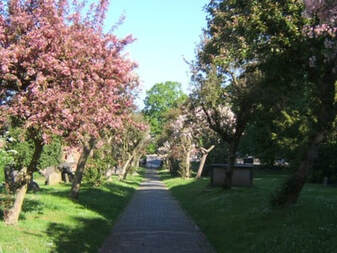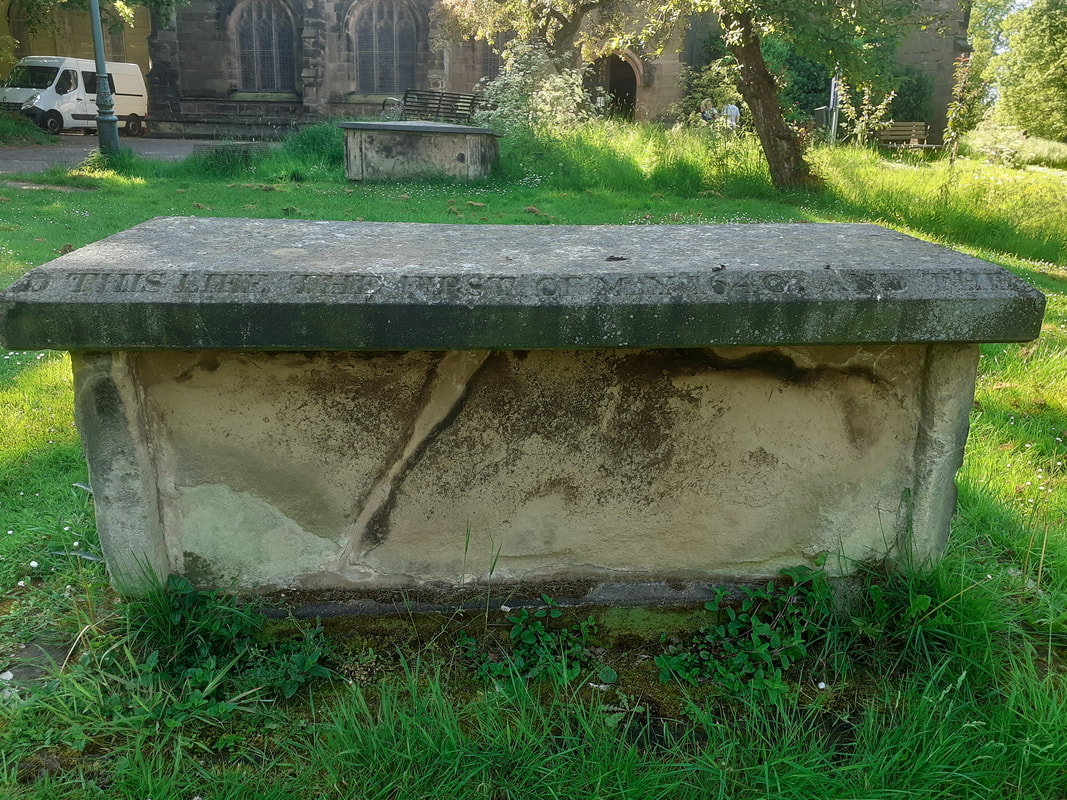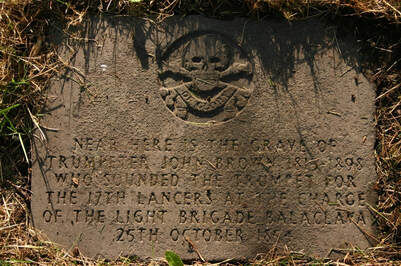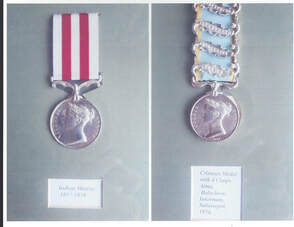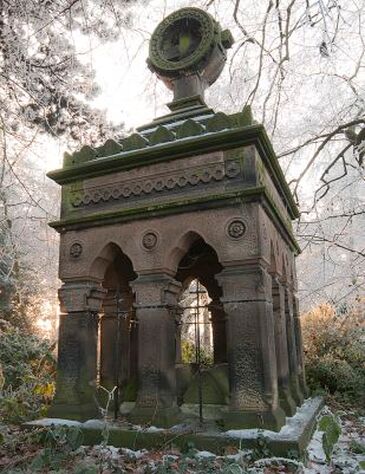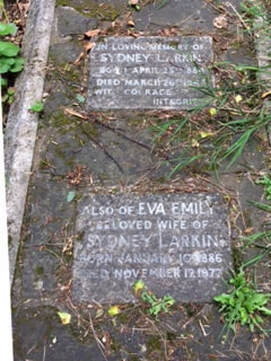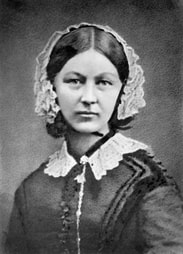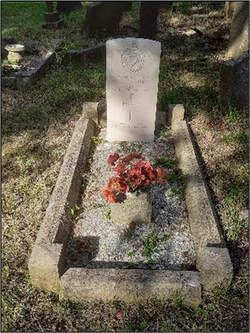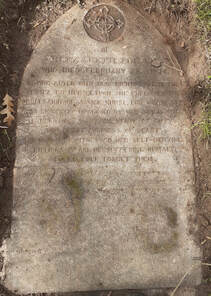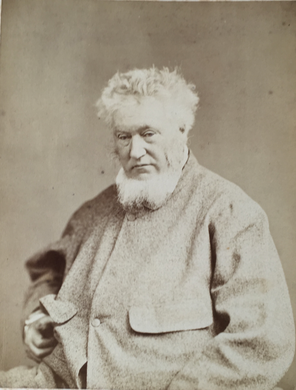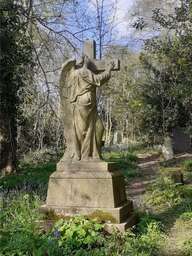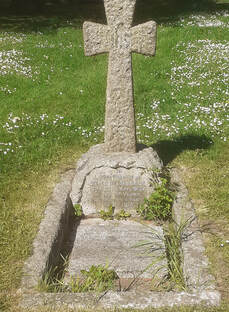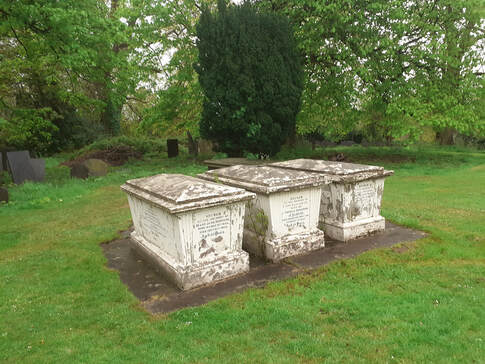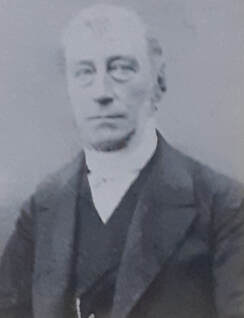A VIRTUAL TOUR OF ST. MICHAEL'S CHURCHYARD - MONUMENTS AND MEMORIALS
St. Michael's churchyard is very old. Allegedly it is one of the five ancient burial sites that were consecrated by St. Augustine in the seventh century (the others being Glastonbury, Canterbury, Lindisfarne and York) and a place of solitude for St. Chad when he was Bishop of Lichfield. Unfortunately, there is not a shred of hard historical evidence for either of these assertions, but they are tales worth telling. Nonetheless it was certainly used in Anglo-Saxon times and a crouched burial, probably of that period or earlier, was found when the church was extended in the 1970s. Throughout the middle ages it was used by local farmers to graze their sheep and cattle and could have been a place where stock was over-wintered before moving out to far flung summer pastures. By 1801 it was custom that only parishioners living in the Greenhill area had the right of pasture and that only sheep should graze the site as cattle were causing damage and desecration of the Churchyard. In the 1970s, many of the gravestones were moved into groups to facilitate maintenance of the old, closed churchyard in the vicinity of the church. Over the years since then this area has become a haven for wildlife, including woodpeckers, foxes, lichen on gravestones and tree branches, fungi, mosses, spiders and insects such as moths, butterflies and grasshoppers. There are over 500 trees, both deciduous and evergreen, with some rarities such as the Japanese Cork Tree and the Oregon Maple. Most of the common British tree species are present. The Churchyard is also noted for its fine display of snowdrops in the early months of the year, followed by crocus, daffodil, bluebell and wild garlic as the Spring arrives, with cow parsley lining the paths in early summer.
In this tour we look at some of the monuments and memorials in the churchyard as indicated on the plan above. Some of those we highlight are interesting simply because of their shape and others because of their associations with individuals. We begin at the church door (A) looking down the tree lined avenue towards the north gate and Lichfield. On the left over the churchyard wall is the old St. Michael’s school, now converted into residential accommodation. In the middle distance we can see the spires of the cathedral and of St Mary’s in the market place, and somewhat closer the Tesco store is very obvious, although it is likely that it won’t have the same longevity as the cathedral and St. Mary’s.
As we walk down the drive from the church, we pass first of all on the right the outdoor Easter garden with its cross and empty tomb, commemorating the central events of the Christian story, the death and resurrection of Jesus (B). Turn left and walk down the avenue of trees to the north gate. On the right we have the grave of of Edward Finney and four of his children, dated 1st May 1640 which makes it the earliest extant grave in the churchyard (C). Edward was one of the Lichfield bailiffs and established a charity in his name at St. Mary's to give bread to the poor.
On the left there is an oddly shaped "Saddleback" grave (D). The inscription is very worn and not easy to read. However, a nineteenth century painting of the same grave, in the William Salt library, gives the date of the inscription as 1674. This date would make the grave one of the oldest monuments in the churchyard as well as one of the oddest. Just beyond it is the prominent Adie family grave (E) from the nineteenth century. Both the Saddleback grave and the Adie grave are scheduled ancient monuments.
On the other side of the tree lined avenue, we see on the left the Commonwealth War Graves Memorial which was installed in 1979 when the churchyard was reorganised (F). The memorial lists all the names of the war casualties buried in the churchyard - around 30 from both world wars.
Close to the war memorial is a memorial to John Browne whose claim to fame was that he was a member of the 17th Lancers during the Crimean War and was one of the trumpeters on the day of the ill-fated Charge of the Light Brigade in 1854 (G). He was born in 1815 in Nottingham and married a Dublin girl named Margaret Barrett. They lived in Wade Street in Lichfield. He was well decorated receiving the Russian Medal with 4 clasps, as well as the Legion of Honour and the Turkish and Indian Medals. He died in 1898 and was buried with full military honours close to this spot. In 2020, John's great, great grandson, Conor Browne visited St Michael's to see his great, great grandfather's grave, bringing with him John’s medals. He has also written an account of his family's memories of John that can be found here. This gives some fascinating detail about the search for the location of the grave.
Carrying on down the main path but bearing right down the path that leads to Burton Old Road (known as the Rector’s Path, as the old Rectory used to be close to the bottom of it), we come to the Chancellor Law monument (H). James Thomas Law (1790–1876) was the chancellor of the diocese of Lichfield from 1821. He was a supporter of the Birmingham School of Medicine and Surgery at Queen's College, Birmingham, of which he was elected honorary warden in 1846, and of Lichfield Theological College. He was Master of St John's Hospital in Lichfield and was a significant benefactor to the city of Lichfield. In 1838 he gave the statue of Samuel Johnson in the Market Square. The monument originally had a clock illuminated by gas and is another scheduled monument.
|
On the opposite side of the Rector's path we find, ten yards or so along a path to the right, the graves of the Larkin family (I). There are around 40 Larkins buried in close proximity, with burial dates between the 1840s and 1970s. These include the grave of Sidney and Eva Larkin, the parents of the poet Philip Larkin, who famously once said f Lichfield ”God, this place is dull”. Behind Sidney and Emma's grave is the memorial to another Philip Larkin who died in 1878. The story is told that when the 18-year-old poet came across this gravestone in St Michael's churchyard in Lichfield, he was understandably perturbed and wrote to a friend , 'I reeled away conscious of a desire to vomit into a homburg hat'.
|
Closer to the Rector’s path, we find the Corfield headstone (J). At first sight this a simple family biographical memorial, until one realizes that all but one of the eight commemorated died on the same day. This was the result of a fire in a house on Breadmarket Street in January, 1871 (next to the Johnson House) that resulted in watch and clock maker William Corfield, his mother, his wife and his four children all suffocating due to smoke inhalation.
We now walk through the trees to a well-made path at the edge of the open area at the east of the church. To the right of the path we have two wartime graves. The first is that of George Wolfe, the son of John and Harriet Wolfe, who died at Caen in France in 1944, and his brother Arthur who died just before the end of the war following a collision between his motorcycle and a pedal cyclist on Christmas Eve 1945, as the war was coming to an end (K). The second is that of Horace Downes, an LMS railway workers were killed during the blackout just south of Lichfield City station when he was struck by a train, and his brother Robert who died in a Japanese P.O.W. camp in Borneo in 1945 (L).
Moving along the path we find the grave of Robert and Joseph Bridgeman (M). Robert was a talented ecclesiastical sculptor and with his son Joseph managed a firm of stonemasons that worked across the country on cathedral and churches – including the figures on the west front of the cathedral. They were both in their turn Sherriff and Mayor.
We now walk through the trees to a well made path at the edge of the open area at the east of the church, Along this path on the right we see the oddly shaped grave memorial of Jesse Rhodes, with an anchor and chain (N). A little further on, on the same side of the path but obscured somewhat by brambles and other foliage. there is the grave of the Durrad family (O). William John Durrad was Lichfield's first station master, and his story is told elsewhere. He was a Churchwarden at St. Michael's in the 1850s, and was buried in 1879 with his wife Elizabeth and his son William Henry, who both predeceased him.
Walking further along the path we come to the grave of John Louis Petit (1801-68), which is graced with its own display board (P). Petit was a Victorian clergyman and topographical water colour artist, who travelled and painted extensively around England, Europe and beyond, mainly painting churches, but also some industrial and agricultural scenes. He was one of the leading architectural speakers and writers of his age, and one of very few who stood against the tide of faux-gothic that was so fashionable in the 19th Century. His work is fully described on the website of the Petit Society. For three years in the 1820s, he was an assistant curate at St. Michael’s. The grave is the last resting place of Petit and six of his siblings.
At the end of the path we come to the new churchyard, which is still open for burials. It contains an area for cremated remains to the left.
|
We turn right here however and walk along the path between the old and the new churchyards. In the trees to the right, we see a large monument from the 1870s to Frances and Thomas, the wife and child of James Trubshaw Johnson, of an angel carrying a cross (O). Whilst the theology behind this is dubious, the effect is rather striking. Leaving the main path and walking past the angel through the trees we come to an open area in front of the east end of the church. There we find the headstone of Elizabeth Logan (R), at the time of writing laid flat on the ground. She was a nurse who served with Florence Nightingale in the Crimea, and was regarded by Nightingale as one of her most gifted staff. Close by we find the grave of Otho Steel, Rector of the parish from 1893 to 1913 (S). There is also a memorial to him within the chancel of the church.
|
Close to the church we can see the flat graves of the Pinches family from the early 1800s (T), Just to the side of the Pinches tomb there is the rather small grave of Percival Howard, another long serving Rector of the parish from 1913 to 1946 (U). He served for some time as an army chaplain in France in the First World War.
We walk now around to the south side of the church and the rather splendid chest graves of the Hodgson family from the 1840s (V). Around the corner on the south side of the church there is the imposing tomb of the Jackson family of Wall (W). It holds the remains of several generations of that family, including those of Thomas Jackson who was headmaster of Dudley Free Grammar School in the late eighteenth century. The grassed region to the left will be the site of the proposed new parish rooms. No doubt the required archaeological investigations will turn up some interesting items.
To the left, near the south entrance to the churchyard leading to Sturgeon's Hill, is the grave of Thomas Gnossall Parr and his family (X). Parr was the last of the Perpetual Curates of the parish and the first Rector. His incumbency lasted from 1831 to 1869, and during that time he carried out 1866 baptisms, 780 marriages and 3168 funerals.
|
In the undergrowth just below the Parr grave, there is the unmarked grave of John Baker (a labourer who died in 1822) and his wife Anne. John and Anne were of no historical significance whatsoever and their gravestone, lost in the churchyard re-organisation, was almost certainly very simple and not at all noteworthy. The only reason for including them here is that they were the great-great-great-great-great paternal grandparents of the compiler of this web page and are thus in some sense responsible for all it contains.
We walk back up the path towards the tower. In the flower bed at the base of the tower is the memorial of John Neve, William Wightman and James Jackson (Y). These men were found guilty of forgery and were hanged at the gallows at the junction of Tamworth Road and London Road. This was to be the last public hanging in Lichfield. The gravestone denotes only the initials of the three men, with the date June 1st 1810. |
A short walk now takes you back to the church door where the tour began. Whilst it is to be hoped that the tour was of interest, the real joy of the churchyard can be found in just wandering along its many byways and experiencing its beauty and peace. It is somewhere to come back to often. There is an option here of following other tours that begin at this point -both inside and outside church


